It is late January and the weather is shifting from chill to pleasant. Cloudy most days, its just right for hot tasty meals. Time for Nimona or Tehari from my Eastern Uttar Pradesh recipes, both with fresh green peas, or spicy Biriyani, Aloo mutter, Chole or of course, the all time favourite, Rajma. On weekends its nice to make a pot of Rajma Masala Curry and have it with rice maybe for lunch and chapatis at dinner. It is also a perfect dish on festive occasions or when there are guests to cater to, as you can serve a great meal with just rajma and rice or roti with a simple salad of onion and tomato slices with lemon wedges.
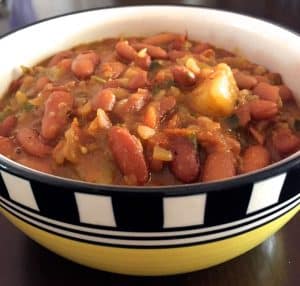
My recipe for Rajma Masala Curry recipe is one I have been following for decades, and the taste always comes out exactly the same. There are a few criteria to making a really tasty Rajma:
- Pre soak the Rajma overnight
- Cook the Rajma till soft
- Use the best available and fresh Garam Masala powder
- Be generous in the volume of onion and tomatoes used (in my recipe, equal volumes of rajma, onion and tomato are suggested)
- Stir the Rajma well with heavy ladle while sautéing. The more you 'bhunav' the masala and the rajma, the better it tastes.
- Ensure the masala does not catch at the bottom of the pan.
Just as in making the Hummus of the right flavour and texture, every step in making Rajma Masala is significant - the soaking, the cooking, making the gravy and sautéing the Rajma, the garnish. I have tried to share with you all the little things that go to make this curry flavourful, nutritious and easy on the stomach. As the red kidney bean is hard and difficult to digest, soaking and cooking till the beans are really soft and fall apart at the touch, is essential. It is definitely possible to soak the beans for just a few hours in hot water, instead of soaking them overnight, but this fast track method does not give the total softness that you will find after soaking them overnight. It is interesting to note that even when cooked very well, the bean still gives texture to the curry and you don't land up with a mushy dish.
Strain and Discard the water in which the Beans are soaked:
Straining and discarding the water in which the bean is soaked is an important step. After straining, throughly rinse the soaked beans in fresh water before cooking them. This is a practice I have always followed (without any logical reasoning) though I have had some doubts as to whether nutrition is lost when the water in which the beans are soaked, is discarded. An item I recently came across in Wikipedia gives insights into why this practice is followed, and validates the cooking process laid down in the recipe below:
"Raw kidney beans contain relatively high amounts of phytohemagglutinin, and thus are more toxic than most other bean varieties if not pre-soaked and subsequently heated to the boiling point for at least 10 minutes. The US Food and Drug Administration recommends boiling for 30 minutes to ensure they reach a sufficient temperature long enough to completely destroy the toxin. Cooking at the lower temperature of 80 °C (176 °F), such as in a slow cooker, can increase this danger and raise the toxin concentration up to fivefold."
Pramod taught me how to make Rajma Masala Curry, and it is a family favourite. Though some of the steps I have followed in this tested and tried recipe may differ from that of popular recipes online, just try making it this way and see how delicious it is.
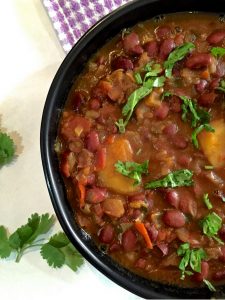
Note: Plan sufficient time for making the Rajma Masala Curry, as, apart from soaking the beans overnight, you may need to pressure cook it twice if it doesn't cook well the first time around. I have observed that rajma from different sources that I purchase from, have different cooking times.
The cooking process below is easy, but it needs patience as there are various steps to be followed.
The quantity of garam masala depends on its potency and freshness. Too much of it can spoil the taste. I use a strong garam masala (bought from a speciality store which has maintained the same standards of taste and quality for the last 15 years), so 1 teaspoon is more than sufficient.
Serving suggestions:
Serve with hot rice and a salad. Goes well with roti and phulka too. Or even with a lightly toasted focaccia or bread. Thick rajma without its liquid is a nice filling for a wrap or quesadilla.
Health and Nutrition:
Kidney Beans are rich in protein. They are also high in fibre including insoluble fibres called alpha-galactosides, which can sometimes cause diarrhoea and flatulence. The fermentation of these fibres also results in the formation of short-chain fatty acids are considered to improve colon health and to reduce the risk of colon cancer
The Beans have a high carbohydrate content, predominantly made up of starch, and are often advised for controlling high sugar in diabetics. This starch is a slow-release carbohydrate, hence it takes longer to be digested than most foods and the resultant rise in blood sugar is gradual and does not cause large blood sugar spikes. Kidney beans have a low glycemic index (the measure of how each food affects the rise in blood sugar after it is consumed).
Kidney beans are a good source of various vitamins and minerals including vitamin K1, iron, molybdenum, folate or B9, copper, manganese, potassium, and phosphorus.
Studies have suggested that bean consumption may give lower risk of overweight and obesity.
Raw or inadequately cooked kidney beans are not advisable as they give risk of toxicity. Use fresh spices to get the best flavours from the Rajma Masala Curry.
"Recipe"
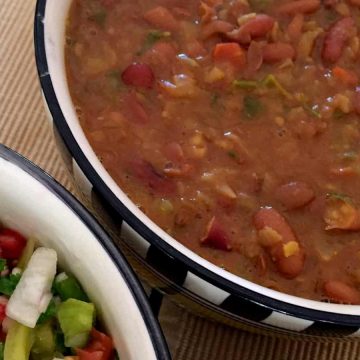
Rajma - How to make the best Rajma Masala Curry
Ingredients
For the Rajma Masala
- 1 cup Rajma -raw Red Kidney Beans
- 4 cups water plus water for soaking the beans
- 2 tablespoons sunflower oil or other cooking oil
- 1 pinch methi fenugreek seeds
- 1 teaspoon sliced fresh chilli or to taste
- 1 cup minced onions
- 1 teaspoon ginger paste or 2 teaspoons minced ginger
- 1 teaspoon garlic paste or 2 teaspoons minced peeled garlic
- 1 cup diced tomatoes
- 1 large potato cubed
- ½ teaspoon turmeric powder includes one pinch to be added while pressure cooking
- 1 teaspoon garam masala powder
- 1 teaspoon red chilli powder or to taste
- 1 tablespoon tomato puree
- 1 teaspoon salt or to taste
For the Garnish
- 2 tablespoons minced fresh coriander leaves half of the quantity is for the masala, half for the garnish
- lemon wedges optional
Instructions
Soaking and cooking the Rajma
- Wash the raw Rajma beans, soak in about 4 cups of water. The water should be at least twice the height of the rajma in the vessel in which soaked. Leave the rajma to soak overnight or for 10-12 hours.
- After the period of soaking is over, drain the water completely and discard the water. Rinse the beans thoroughly with fresh water. Though Rajma is nutritious, the raw rajma beans contain a toxic element which is removed by soaking, rinsing and cooking in high temperature for adequate time as detailed in the instructions below. Remember that cooking times can vary depending on the variety and quality of the beans, so give yourself plenty of time to prepare the curry.
- Pressure cook the soaked rajma beans in about 4 cups of water, a large pinch of turmeric and ½ teaspoon of salt. Cook on high flame and after the first whistle, reduce the stove flame and cook for another 4 whistles. After turning off the stove, allow the cooker to cool down and pressure to be released on its own, as the rajma will continue to cook during this time (about 10 minutes)
- Once the cooker has cooled enough for the lid to be opened, check if the rajma has been cooked soft - press one between your fingers (cool the bean first!) and see if it gets mashed. If not soft and mashable, keep again in the cooker (add upto one cup of water only if all the water has been absorbed) and pressure cook again for 4 whistles on high flame. Usually if the rajma has been soaked overnight, it should get cooked the first time around. Drain the cooked rajma and this time retain the water in which it is cooked.
Prepare the ingredients for Rajma Masala Curry
- Slice the chillies, mince the garlic and ginger. If preferred, use ginger and garlic pastes instead. The minced garlic and ginger add pleasing texture to the food. Mince the onion, dice the tomato into small even sized pieces (about 1 cm cubes) so that they cook fast and uniformly.
- Peel the potato and cube it so you get pieces of about an inch in length. You don't want small pieces of potato in the rajma, large chunks are better. Place the potato cubes in a bowl of water till ready to use.
- Wash and mince the fresh coriander leaves. I usually leave them in a small bowl of water so they remain fresh till I need them, and then I drain and mince the leaves just before using. Half this quantity is to be added to the masala, and the rest for garnish.
To make the Rajma Masala
- Heat a large pan on the stove and add oil. When the oil is hot, add fenugreek (methi) seeds, allow to sauté for 5 seconds or till they burst. Don't let them blacken. Add green chilli slices, turn them so they scald all over (about 5 seconds)
- Add minced onions, stir well and sauté till the onions are fried, 1 -2 minutes on low flame, stirring frequently so the onion does not catch at the bottom of the pan. Ensure the onions don't brown.
- Add ginger and then garlic (paste or minced). Stir each well, sauté for about 5 seconds each, on low flame. Again ensure the garlic does not begin to brown.
- Keeping the stove flame on low, add the tomato slices. Stir well. Drain and add the potato slices, stir well. Always stir so that the onions and garlic are lifted away from the bottom of the pan as they can easily catch and char.
- Add turmeric powder, red chilli powder and garam masala. Most recipes suggest adding the garam masala at the end (after adding the rajma) so that its aroma is retained in the curry, and you could do that too. I add the garam masala at this stage while making the masala. (Perhaps it is because I use a garam masala which is very aromatic and the aroma is retained even after pressure cooking the rajma masala as in the steps below.)
- Again stir the entire masala well and sauté for 2 minutes on low flame. Add about half the minced coriander leaves and reserve the rest for garnish. Stir! Add the tomato puree, and stir.
- Add the drained cooked rajma, stir briskly, (I stir till my arm aches!) turning the rajma and its masala several times, scraping the bottom of the pan so that masala does not stick. Stir for at least 5 minutes. Transfer the contents of the pan to the pressure cooker.
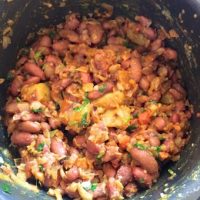
- Add back the water in which the rajma was cooked. You need sufficient water to just cover the rajma masala. Add more or less water depending on this. If you need to add fresh water as all the cooking water has been absorbed, ideally add warm water.
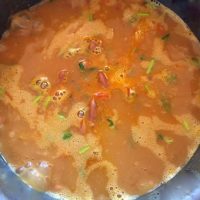
- Stir once. Add salt to taste. (remember you have added a little salt while cooking the rajma, so a taste check would be helpful here). Close the cooker, and cook on high for 2-3 whistles.
- To serve: Transfer the rajma masala to a serving dish, garnish generously with minced coriander leaves. I keep lemon wedges available for those who want to squeeze some lemon juice on the rajma.
- Serve with hot rice and a salad. Goes well with roti and phulka too. Or even with a lightly toasted focaccia or bread. Thick rajma without its liquid is a nice filling for a wrap or quesadilla.


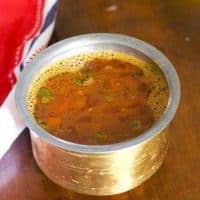
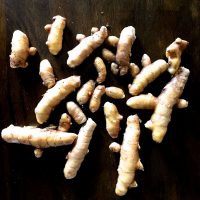
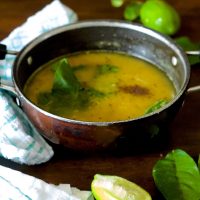
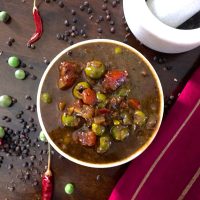
Hemalatha says
Very very delicious Rajma Masala. Spices are mild but the dish is awesome. Yummy 😋. Thanks for sharing.
Sujata Shukla says
Thank you so much! I’m so glad you liked how the recipe turned out!
Hemalatha says
Turned out wonderful 👍 Can you recommend a good brand of garam masala ease ?
Sujata Shukla says
There’s one brand I love. Nuts N Spices - they have stores in Chennai, Bangalore and a couple of other places in south India. I think we can order online too. All their spices/ spice powders are fresh and the garam masala is very good. It is rather strong so I use lesser than the quantity I would otherwise use. https://www.nutsnspices.in/
Hemalatha says
Super info. Thank you very much
Sujata Shukla says
❤️❤️
Lux says
Guess whats cooking tonight!
Sujata Shukla says
Send a picture of the rajma please!
jayashreetrao says
Looks delicious and nicely explained post.
Sujata Shukla says
Thank you Jayashree! Do let me know if you try out the recipe
Mridula Varghese says
Almost the final word in comfort food around our household for 3 generations now& makes for perfect weekend meals!